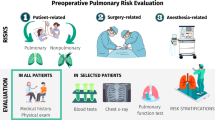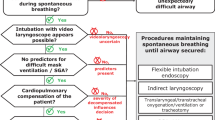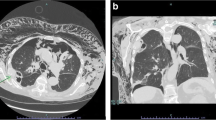Abstract
Purpose of Review
Wheezing in infancy is a common presentation with many potential causes. In writing this review, we sought to summarize the newest recommendations and testing available for the more common etiologies of wheezing.
Recent Findings
Regarding the diagnosis of asthma, the modified asthma predictive index has recently been established as a useful predictive tool. Non-breath held multidetector CT with 3D volume rendering airway images is also a newer helpful diagnostic tool for tracheomalacia due to ease of use and its 100% positive predictive value. We found vaccines have greatly reduced the prevalence of epiglottitis, while advances in surgery are improving outcomes in infants with vascular rings.
Summary
Wheezing in infants is a common problem with an extensive differential diagnosis from relatively benign to life threatening. To prevent over-looking a diagnosis that potentially requires surgical correction or emergent care, we recommend a structured approach to the history and physical exam with targeted testing directed towards the most likely diagnoses as outlined in this review.
Similar content being viewed by others
References
Papers of particular interest, published recently, have been highlighted as: • Of importance •• Of major importance
Griffiths AG, Green TP. Chronic or Recurrent Respiratory Symptoms. In: Kliegman RM, Stanton BF, St. Geme JW, Schor NF, editors. Nelson Textbook of Pediatrics, Twentieth Edition. Elsevier Inc; 2016.
Bessa OA, Leite AJ, Sole D, Mallol J. Prevalence and risk factors associated with wheezing in the first year of life. J Pediatr. 2014;90(2):190–6. https://doi.org/10.1016/j.jped.2013.08.007.
Belhassen M, De Blic J, Laforest L, Laigle V, Chanut-Vogel C, Lamezec L, et al. Recurrent wheezing in infants: a population-based study. Medicine (Baltimore). 2016;95(15):e3404. https://doi.org/10.1097/MD.0000000000003404.
Fogaca HR, Marson FA, Toro AA, Sole D, Ribeiro JD. Epidemiological aspects of and risk factors for wheezing in the first year of life. J Bras Pneumol. 2014;40(6):617–25. https://doi.org/10.1590/S1806-37132014000600005.
Krawiec ME, Westcott JY, Chu HW, Balzar S, Trudeau JB, Schwartz LB, et al. Persistent wheezing in very young children is associated with lower respiratory inflammation. Am J Respir Crit Care Med. 2001;163(6):1338–43. https://doi.org/10.1164/ajrccm.163.6.2005116.
de Sousa RB, Medeiros D, Sarinho E, Rizzo JA, Silva AR, Bianca AC. Risk factors for recurrent wheezing in infants: a case-control study. Rev Saude Publica. 2016;50:15. https://doi.org/10.1590/S1518-8787.2016050005100.
•• Ren CL, Charles R, Esther J, Debley JS, Sockrider M, Yilmaz O, et al. Official American Thoracic Society clinical practice guidelines: diagnostic evaluation of infants with recurrent or persistent wheezing. Am J Respir Crit Care Med. 2016;194(3):356–73. https://doi.org/10.1164/rccm.201604-0694ST. Committee-based answers to the controversial questions surrounding work-up and treatment of infants with wheezing. Summary and quality of evidence are discussed for each question.
Shah RK, Stocks C. Epiglottitis in the United States: national trends, variances, prognosis, and management. Laryngoscope. 2010;120(6):1256–62. https://doi.org/10.1002/lary.20921.
Tibballs J, Watson T. Symptoms and signs differentiating croup and epiglottitis. J Paediatr Child Health. 2011;47(3):77–82. https://doi.org/10.1111/j.1440-1754.2010.01892.x.
Stankiewicz JA, Bowes AK. Croup and epiglottitis: a radiologic study. Laryngoscope. 1985;95(10):1159–60.
Sobol SE, Zapata S. Epiglottitis and croup. Otolaryngol Clin N Am. 2008;41(3):551–566, ix. https://doi.org/10.1016/j.otc.2008.01.012.
Carden KA, Boiselle PM, Waltz DA, Ernst A. Tracheomalacia and Tracheobronchomalacia in children and adults. Chest. 127(3):984–1005. https://doi.org/10.1378/chest.127.3.984.
Murgu SD, Egressy K, Laxmanan B, Doblare G, Ortiz-Comino R, Hogarth DK. Central airway obstruction: benign strictures, tracheobronchomalacia, and malignancy-related obstruction. Chest. 2016;150(2):426–41. https://doi.org/10.1016/j.chest.2016.02.001.
Lee S, Im SA, Yoon JS. Tracheobronchomalacia in infants: the use of non-breath held 3D CT bronchoscopy. Pediatr Pulmonol. 2014;49(10):1028–35. https://doi.org/10.1002/ppul.22931.
van der Zee DC, Straver M. Thoracoscopic aortopexy for tracheomalacia. World J Surg. 2015;39(1):158–64. https://doi.org/10.1007/s00268-014-2798-2.
Ando M, Nagase Y, Hasegawa H, Takahashi Y. External stenting: a reliable technique to relieve airway obstruction in small children. J Thorac Cardiovasc Surg. 2017;153(5):1167–77. https://doi.org/10.1016/j.jtcvs.2016.12.041.
Shieh HF, Smithers CJ, Hamilton TE, Zurakowski D, Rhein LM, Manfredi MA, et al. Posterior tracheopexy for severe tracheomalacia. J Pediatr Surg. 2017;52(6):951–5. https://doi.org/10.1016/j.jpedsurg.2017.03.018.
Bjornson C, Brindle M, Bailey JM, Mitchell I, Soles M. Delayed diagnosis of high proximal tracheoesophageal fistula in esophageal atresia and a novel approach to the treatment of tracheomalacia by submanubrial tracheopexy. SpringerPlus. 2014;3(1):113. https://doi.org/10.1186/2193-1801-3-113.
Laya BF, Restrepo R, Lee EY. Practical imaging evaluation of foreign bodies in children: an update. Radiol Clin N Am. 2017;55(4):845–67. https://doi.org/10.1016/j.rcl.2017.02.012.
•• Global Initiative for Asthma. Global Strategy for Asthma Management and Prevention, 2017. Available from: www.ginasthma.org. Updated guidelines for management of asthma in children and adults. Prolonged cough and cough without cold symptoms, independent of infant wheezing, are now indicated as predictors of asthma in infants.
Martinati LC, Boner AL. Clinical diagnosis of wheezing in early childhood. Allergy. 1995;50(9):701–10.
AARC clinical practice guideline-infant-toddler PFTs-2008 revision & update. Respiratory Care. 332 2008;53:929–45
National Heart, Lung, and Blood Institute. National Asthma Education and Prevention Program. Expert Panel Report 3: Guidelines for the Diagnosis and Management of Asthma; 2007 Aug 28. http://www.nhlbi.nih.gov/guidelines/asthma/asthgdln.pdf.
Castro-Rodriguez JA, Holberg CJ, Wright AL, Martinez FD. A clinical index to define risk of asthma in young children with recurrent wheezing. Am J Respir Crit Care Med. 2000;162(4 Pt 1):1403–6. https://doi.org/10.1164/ajrccm.162.4.9912111.
Guilbert TW, Morgan WJ, Zeiger RS, Bacharier LB, Boehmer SJ, Krawiec M, et al. Atopic characteristics of children with recurrent wheezing at high risk for the development of childhood asthma. J Allergy Clin Immunol. 2004;114(6):1282–7. https://doi.org/10.1016/j.jaci.2004.09.020.
Chang TS, Lemanske RF Jr, Guilbert TW, Gern JE, Coen MH, Evans MD, et al. Evaluation of the modified asthma predictive index in high-risk preschool children. J Allergy Clin Immunol Pract. 2013;1(2):152–6. https://doi.org/10.1016/j.jaip.2012.10.008.
Elliott M, Heltshe SL, Stamey DC, Cochrane ES, Redding GJ, Debley JS. Exhaled nitric oxide predicts persistence of wheezing, exacerbations, and decline in lung function in wheezy infants and toddlers. Clin Exp Allergy. 2013;43(12):1351–61. https://doi.org/10.1111/cea.12171.
Hall CB, Weinberg GA, Iwane MK, Blumkin AK, Edwards KM, Staat MA, et al. The burden of respiratory syncytial virus infection in young children. N Engl J Med. 2009;360(6):588–98. https://doi.org/10.1056/NEJMoa0804877.
Cheuk DK, Tang IW, Chan KH, Woo PC, Peiris MJ, Chiu SS. Rhinovirus infection in hospitalized children in Hong Kong: a prospective study. Pediatr Infect Dis J. 2007;26(11):995–1000. https://doi.org/10.1097/INF.0b013e3181586b63.
Davies HD, Wang EE, Manson D, Babyn P, Shuckett B. Reliability of the chest radiograph in the diagnosis of lower respiratory infections in young children. Pediatr Infect Dis J. 1996;15(7):600–4.
• Beigelman A, Isaacson-Schmid M, Sajol G, Baty J, Rodriguez OM, Leege E, et al. Randomized trial to evaluate azithromycin’s effects on serum and upper airway IL-8 levels and recurrent wheezing in infants with respiratory syncytial virus bronchiolitis. J Allergy Clin Immunol. 2015;135(5):1171–1178 e1. https://doi.org/10.1016/j.jaci.2014.10.001. Proof-of -concept trial revealing some benefit of Azithromycin in treating RSV bronchiolitis; a condition only treated with supportive measures as of now. Will need further studies to support the findings.
Torgerson DG, Giri T, Druley TE, Zheng J, Huntsman S, Seibold MA, et al. Pooled sequencing of candidate genes implicates rare variants in the development of asthma following severe RSV bronchiolitis in infancy. PLoS One. 2015;10(11):e0142649. https://doi.org/10.1371/journal.pone.0142649.
Wang Y, Dai W, Sun Y, Chu X, Yang B, Zhao M. Congenital bronchial atresia: diagnosis and treatment. Int J Med Sci. 2012;9(3):207–12. https://doi.org/10.7150/ijms.3690.
Reisman J, Corey M, Canny G, Levison H, Kerem E, Bentur L. Wheezing in infants with cystic fibrosis: clinical course, pulmonary function, and survival analysis. Pediatrics. 1992;90(5):703–6.
Ren CL, Konstan MW, Rosenfeld M, Pasta DJ, Millar SJ, Morgan WJ, et al. Early childhood wheezing is associated with lower lung function in cystic fibrosis. Pediatr Pulmonol. 2014;49(8):745–50. https://doi.org/10.1002/ppul.22894.
Regelmann WE, Schechter MS, Wagener JS, Morgan WJ, Pasta DJ, Elkin EP, et al. Pulmonary exacerbations in cystic fibrosis: young children with characteristic signs and symptoms. Pediatr Pulmonol. 2013;48(7):649–57. https://doi.org/10.1002/ppul.22658.
Backer CL, Monge MC, Popescu AR, Eltayeb OM, Rastatter JC, Rigsby CK. Vascular rings. Semin Pediatr Surg. 2016;25(3):165–75. https://doi.org/10.1053/j.sempedsurg.2016.02.009.
Miranda JO, Callaghan N, Miller O, Simpson J, Sharland G. Right aortic arch diagnosed antenatally: associations and outcome in 98 fetuses. Heart. 2014;100(1):54–9. https://doi.org/10.1136/heartjnl-2013-304860.
Licari A, Manca E, Rispoli GA, Mannarino S, Pelizzo G, Marseglia GL. Congenital vascular rings: a clinical challenge for the pediatrician. Pediatr Pulmonol. 2015;50(5):511–24. https://doi.org/10.1002/ppul.23152.
Evans WN, Acherman RJ, Ciccolo ML, Carrillo SA, Mayman GA, Luna CF, et al. Vascular ring diagnosis and management: notable trends over 25 years. World J Pediatr Congenit Heart Surg. 2016;7(6):717–20. https://doi.org/10.1177/2150135116661279.
Hinton RB, Ware SM. Heart failure in pediatric patients with congenital heart disease. Circ Res. 2017;120(6):978–94. https://doi.org/10.1161/CIRCRESAHA.116.308996.
Weiss LN. The diagnosis of wheezing in children. Am Fam Physician. 2008;77(8):1109–14.
Author information
Authors and Affiliations
Corresponding author
Ethics declarations
Conflict of Interest
The authors declare no conflicts of interest relevant to this manuscript.
Human and Animal Rights and Informed Consent
This article does not contain any studies with human or animal subjects performed by any of the authors.
Additional information
This article is part of the Topical Collection on Pediatric Allergy and Immunology
Rights and permissions
About this article
Cite this article
Muglia, C., Oppenheimer, J. Wheezing in Infancy: An Overview of Recent Literature. Curr Allergy Asthma Rep 17, 67 (2017). https://doi.org/10.1007/s11882-017-0737-7
Published:
DOI: https://doi.org/10.1007/s11882-017-0737-7




